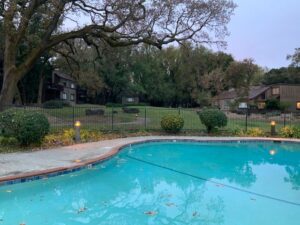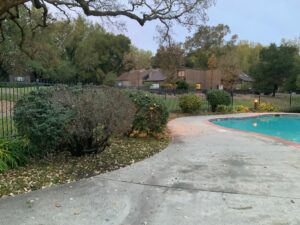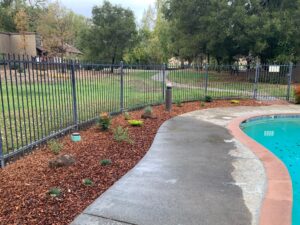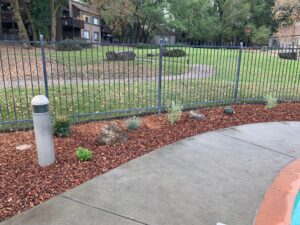Landscaping
Pool Project
The pool landscaping project was completed in December of 2020. The work took about two full days and included: removal of all plants, installation of a weed barrier, new plantings, wood chips, and a
drip irrigation system.
Owl Project
Our Owl Project is moving ahead. Wild Wing Co. will be installing five owl boxes at various locations on the property, providing a natural, year-round pest control solution for our community. Three rodent bait modules will also be included as part of the installation, subject to a request for clarification as to how the bait modules are to be serviced (per the March 28th Monthly Board Meeting).
View map of owl box locations (PDF file).
Landscape Plan (2017-18)

The Board is currently working with a professional landscape designer to improve this area with new plantings and irrigation.
Details of the plan, include:
• Landscape Planting Plan
• Plant List
• Plant Images
Landscape Plan – 2017 (click to download)
Deer Fencing
In order to protect the new plantings, there will be temporary fencing around this area. This includes 200 linear feet of fence with posts every ten feet. The plan is to use 7.5′ tall black flex deer fence installed on 8′ tall powder green posts.
Type of deer fencing (click to view)
Project Quote
Landscape Contract (Labor) – $3,780 (108 hrs. with 3-person crew)
Plantings (Material Cost) – $1,800
Irrigation (Drip system) – $860
Deer Fencing (Material Cost) – $550
Total Project = $6,990
Owners who would like to provide comments or feedback, may either send an e-mail or send a letter to: Ignacio Creek HOA, 300 Indian Way, Novato, CA 94949.

The Board of Directors recently met with the site supervisor and the regional supervisor of Gardeners Guild to discuss the present state of our landscaping. The discussion centered on the lack of due diligence on the part of the contractor in maintaining the property in tip top shape. The Board had particular concerns with the overgrown entryways of residences, the lack of pruning the bushes and shrubs, removal of dead and dying plants and ornamental trees, the rotational clearing around buildings and a general tendency of just mowing and blowing when servicing our property. It was presented in very clear terms that unless Gardeners Guild took immediate corrective and sustained action moving forward to address these concerns, that we would begin looking for services from a new provider.
The Board then conducted a walkthrough of the property with Gardeners Guild to inspect the present conditions. This resulted in an understanding that GG would provide three men each week to adequately address our needs. It was further agreed that starting immediately, a separate crew would be brought on to the property to begin the building clean up rotation in area A (see map.) We also specified that each building on the rotation map be cleared within two-feet from the siding of any old, dead and dying vegetation, accumulated leaves along with the removal and trimming of branches and limbs within that zone. That all shrubs and bushes at each structure be pruned and lowered with certain plants being eliminated in favor of others. We also agreed that the removal of some vegetation be conducted to define the landscaping by eliminating inter-grown plants and to eliminate the jumbled and chaotic look.
The issue of highly flammable vegetation will be dealt with either by outright removal or where possible, by adequate pruning and raking out of debris and making sure the vegetation is frequently watered to prevent its drying out. “Fire-ladders” will be eliminated wherever they are found to exist.
We further agreed that blowing of streets, paths and walkways to remove leaves not be a weekly undertaking. That the time spent blowing leaves would be better spent on specific projects and on the rotation maintenance. However, when blowing is conducted, the leaves collected will be removed from the property and not simply blown back into the vegetation.
Another important part of the overall work includes that all sprinklers will be checked and aligned so as not to spray against the walls and sides of buildings and that all rocks in the landscaping be raised above grade. Also all utility closets be inspected and cleared of debris.
We further agreed that all sidewalks, pathways and stairs would be clipped and cleared to insure adequate and safe passage to each home, and that a monthly review of entryways would be conducted.
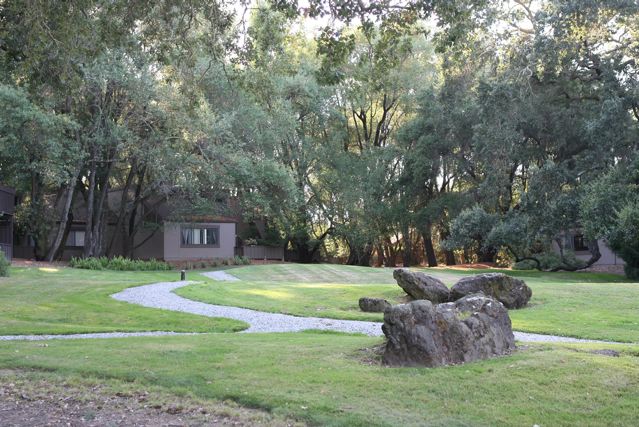
What does this specifically mean for you and your unit?
You should see a vast improvement in the overall appearance to the landscaping both immediately and in the next few months around your home. However, you should be aware that in some instances a good deal of hard pruning and removal will be done in order to bring about these changes. The opening of mature and neglected bushes through pruning will expose their inner areas that initially will look woody and perhaps less than pleasing. This pruning however will result in stimulating new growth over the next few months and before too long the new growing season will begin filling them in. The board is aware that if diligent periodic trimming and pruning had been undertaken, the necessity for radical pruning would not be an issue.
Why are some plants being removed, while other similar plants remain in other areas?
The board, after consulting with the Novato Fire Marshall and our landscaper site supervisor, has reviewed in every instance what plants are to be removed. Considerations for removal include the age of the plants, some having lived beyond their usefulness, their flammability and proximity to structures and available irrigation. Additional considerations include issues presented to the board by homeowners regarding “blind spots” that large plants and bushes pose to drivers when entering and leaving their garages and parking places.
Will something be planted to replace the plants removed?
Not in every instance. Some plants have been removed to better define the landscaping and because of a lack of irrigation. Some plants will be replaced with more appropriate choices considering their location, irrigation needs and maintenance requirements.
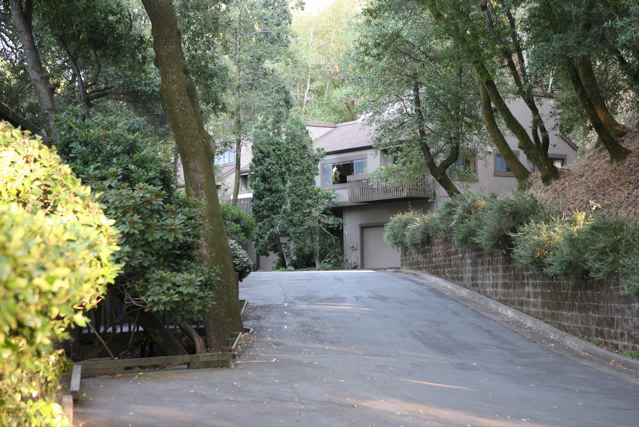
When will my area be worked on?
Because this work is being undertaken on a rotational basis, it may take awhile before your specific area is worked on. The gardeners have been instructed to move at a reasonable pace meaning that approximately every two weeks they should be working in the next area of the rotation. Once the entire rotation has been completed, it will begin again at area A. Updates will be posted on the web site indicating the progress of the rotation.
Does the HOA have a list of approved plants?
Yes. The attached lists were developed based on the original design of Lester Hawkins, an award-winning landscape architect who contributed to the early layout of the common area landscaping for Ignacio Creek. The original list was updated in February 1999.
Can I direct the gardeners working in my area about what to do around my unit?
The crew has been informed not to take instruction or orders from homeowners. Homeowner concerns should be directed to the board either by leaving a message at 415-883-7641 or by email.
What happens if something is overlooked or not completed?
You should advise the board either by leaving a message at 415-883-7641 or by email.
NOTE: Please be aware that any personal property in the common area around your building may be removed and disposed of without notice. All personal property should be placed on your deck or patio at all times to avoid problems.
Landscape Improvements
Background – Several owners have inquired as to how they can offer assistance in planning landscape improvements in the vicinity of their residence. The following is an outline of the process the Association uses to plan and implement such changes:
- Owner requests – Owners who would like to see particular plantings in their area, should observe the following guidelines:
- Consult the HOA Plant List. Note: Certain plants such as rhododendrons have been removed (in that case because they can contribute to the spread of Sudden Oak Death).
- Consult your neighbors – It is preferable for all owners in the immediately affected vicinity to agree on a plan (so we don’t receive objections from your neighbors later).
- Present your request to the Board – This can be done either by mail, e-mail or by attending a Board Meeting.
- Association Action – The HOA will review such requests with our Landscaping Service in order to determine which plants are available and suitable for the requested location. Please note that not all plants on the Approved List are appropriate in every location. Landscape projects are discussed (and budgets approved) at the regularly scheduled HOA Board Meetings on the 4th Thursday of each month. If you cannot attend the meeting, please check the Minutes for updates on the progress of the project.
- New Plantings – Finally, when viewing the new plantings in an area, please note the following:
- New plantings are not mature and may not show their colors for some time after they are planted. Give the plantings and other landscape modifications a few weeks before drawing conclusions about their appearance.
- Protective cages – In order to protect new plantings from deer and other wildlife, the gardeners install protective screens. We generally use screens with wooden stakes.
- Wood chips – Unfortunately, our landscape budget does not permit us to use more expensive wood chips (e.g., redwood bark). Keep in mind that we have over 14 acres of property with 79 units. The wood chips we use are provided for free from recycled material by our tree service contractor.
- Ground cover – We generally avoid the use of plantings for ground cover close to buildings and walkways. Instead, we prefer to use wood chips to control weeds and fill otherwise bare sections. This reduces maintenance (as the ground cover often invades pathways) and increases the retention of water in the soil – which is particularly helpful during droughts. This also avoids creating nesting grounds for rodents and other pests in close proximity to the residences.
Most importantly, please be patient with the changes to the landscaping. If you have constructive ideas you would like to offer, they are most welcome (particularly when offered prior to the start of the project).
Below is a link to a series of photographs of the various plantings that were approved by the HOA for installation this month (June 2014).

